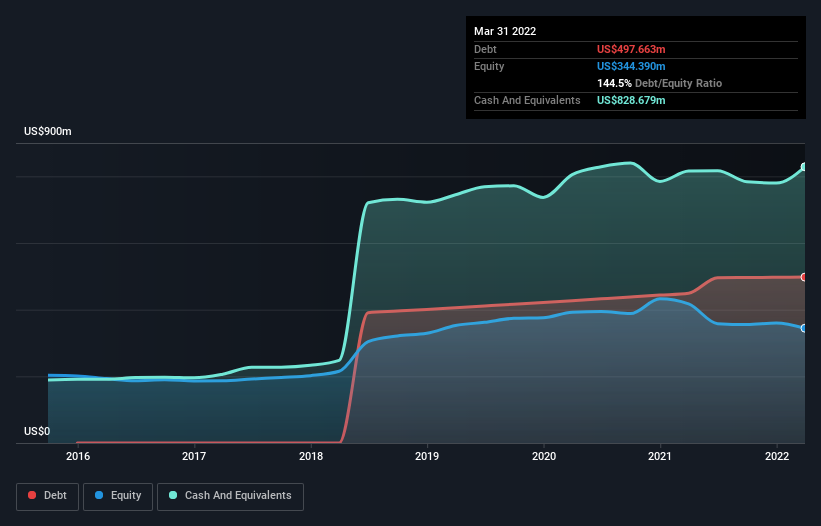New Relic (NYSE:NEWR) Has Debt But No Earnings; Should You Worry?
Some say volatility, rather than debt, is the best way to think about risk as an investor, but Warren Buffett famously said that 'Volatility is far from synonymous with risk.' When we think about how risky a company is, we always like to look at its use of debt, since debt overload can lead to ruin. We note that New Relic, Inc. (NYSE:NEWR) does have debt on its balance sheet. But the real question is whether this debt is making the company risky.
When Is Debt Dangerous?
Generally speaking, debt only becomes a real problem when a company can't easily pay it off, either by raising capital or with its own cash flow. Ultimately, if the company can't fulfill its legal obligations to repay debt, shareholders could walk away with nothing. However, a more frequent (but still costly) occurrence is where a company must issue shares at bargain-basement prices, permanently diluting shareholders, just to shore up its balance sheet. Of course, the upside of debt is that it often represents cheap capital, especially when it replaces dilution in a company with the ability to reinvest at high rates of return. When we think about a company's use of debt, we first look at cash and debt together.
Check out our latest analysis for New Relic
What Is New Relic's Net Debt?
As you can see below, at the end of March 2022, New Relic had US$497.7m of debt, up from US$449.4m a year ago. Click the image for more detail. However, it does have US$828.7m in cash offsetting this, leading to net cash of US$331.0m.
A Look At New Relic's Liabilities
According to the last reported balance sheet, New Relic had liabilities of US$515.5m due within 12 months, and liabilities of US$567.8m due beyond 12 months. Offsetting this, it had US$828.7m in cash and US$226.2m in receivables that were due within 12 months. So its liabilities total US$28.4m more than the combination of its cash and short-term receivables.
This state of affairs indicates that New Relic's balance sheet looks quite solid, as its total liabilities are just about equal to its liquid assets. So it's very unlikely that the US$3.46b company is short on cash, but still worth keeping an eye on the balance sheet. Despite its noteworthy liabilities, New Relic boasts net cash, so it's fair to say it does not have a heavy debt load! When analysing debt levels, the balance sheet is the obvious place to start. But ultimately the future profitability of the business will decide if New Relic can strengthen its balance sheet over time. So if you're focused on the future you can check out this free report showing analyst profit forecasts.
In the last year New Relic wasn't profitable at an EBIT level, but managed to grow its revenue by 18%, to US$786m. That rate of growth is a bit slow for our taste, but it takes all types to make a world.
So How Risky Is New Relic?
We have no doubt that loss making companies are, in general, riskier than profitable ones. And in the last year New Relic had an earnings before interest and tax (EBIT) loss, truth be told. Indeed, in that time it burnt through US$15m of cash and made a loss of US$250m. With only US$331.0m on the balance sheet, it would appear that its going to need to raise capital again soon. Overall, we'd say the stock is a bit risky, and we're usually very cautious until we see positive free cash flow. The balance sheet is clearly the area to focus on when you are analysing debt. However, not all investment risk resides within the balance sheet - far from it. For example, we've discovered 3 warning signs for New Relic that you should be aware of before investing here.
At the end of the day, it's often better to focus on companies that are free from net debt. You can access our special list of such companies (all with a track record of profit growth). It's free.
Have feedback on this article? Concerned about the content? Get in touch with us directly. Alternatively, email editorial-team (at) simplywallst.com.
This article by Simply Wall St is general in nature. We provide commentary based on historical data and analyst forecasts only using an unbiased methodology and our articles are not intended to be financial advice. It does not constitute a recommendation to buy or sell any stock, and does not take account of your objectives, or your financial situation. We aim to bring you long-term focused analysis driven by fundamental data. Note that our analysis may not factor in the latest price-sensitive company announcements or qualitative material. Simply Wall St has no position in any stocks mentioned.

 Yahoo Finance
Yahoo Finance 
